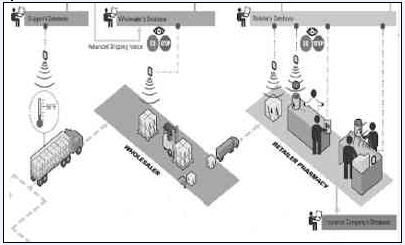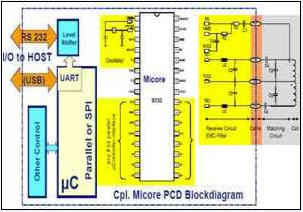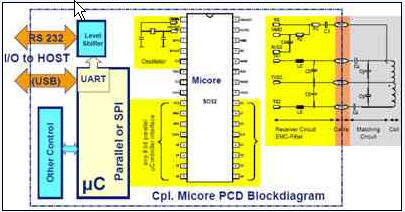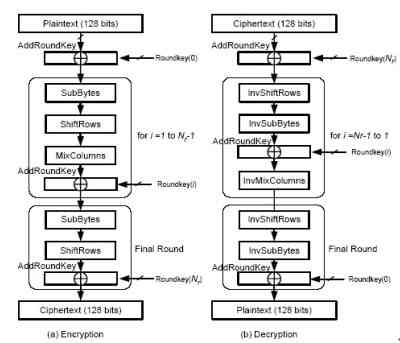It has several advantages over barcode technology, including:
1.) Can store more data
2.) can integrate certain intelligence into the tag
3.) can scan outside a certain distance
4.) Can reduce human intervention
All of this is made possible by the use of the MCU.
Impact of EPC technology on smart labels
In the deployment of consumer layers, next-generation tagging systems must develop a new level of sophistication to address the complexities of new applications and global interoperability.
Just as Unified Product Coding (UPC) is the basic identity of bar code technology, a consortium called EPCglobal has also created an Electronic Product Code (EPC) for RFID. The EPC code is 64 bits or 96 bits long. It will be a lookup in a networked database, and the data in the database must be accessible in real time.
At some point, the tag must communicate with a host system located outside of the company's intranet. Companies can collaborate with their partners to provide EPC Information Services (EPCIS). This will require more standardization, interoperability and security.

Figure 1: Label application runs through the entire process from warehousing to retail
32-bit MCU for complex RFID systems


TAG: mcu
Because of their cost-effectiveness, 32-bit MCUs are well suited for complex RFID automatic ID systems. As pointed out earlier, most of the redesign work will be done on the reader. Figure 2 shows a block diagram of a basic reader.

Figure 2: RFID reader using MCU and reader IC
The MCU can communicate with a larger EPCIS database using any of several popular serial interfaces, including UART and USB serial channels. The communication between the reader and the tag is the responsibility of the MCU.
The system relies on data stored in the EEPROM and has several basic features:
• Each tag has a unique serial number that is stored in EEPROM blocks 1 and 2.
• Two special function control codes: Electronic Article Stealing (EAS) and Quiet Mode for security and on/off operations (stored in block 3).
· Each tag has an 8-bit serial number and an 8-bit application identification number (both stored in block 4). These two codes are not unique to the tag.
· The remaining memory is used for user data.
· 256 time slots are defined and the tag is broadcast in one of the time slots
If a reader looks for a particular tag or set of tags, it can use the serial number and the application identification number criteria to query all tags that are within its operating range. The reader needs to perform a series of interrogation operations on the tag. This type of interaction is usually a read of the user data in the tag, but subsequent writes may occur.
The whole process is roughly as follows:
· Repeat the operation of the query tag until the data is no longer detected
· When tags that match the required series and application code are found, the reader will assign time slots to them through the entire sorting process.
• A label that does not meet the series/application code standard is instructed to stop broadcasting its serial number.
· In order to make the sorting process as fast as possible, an optimization algorithm is used. Optimization is based on a simulation of the average number of commands required to complete the process. The fast execution of these algorithms is best done using a 32-bit MCU.
All of this puts a heavy load on the MCU. Tags need to have higher performance. With a 32-bit MCU and large on-chip flash memory, local database information storage can be achieved without endless communication with the host.
Smart card reader data encryption and decryption structure
Encryption can be implemented in software or through hardware and software components. The main advantage of pure software encryption is that it is cheap. On the other hand, hardware/software-based security measures will be more secure and performance will improve considerably.
In addition to the performance weaknesses of 8-bit and 16-bit systems handling software encryption, software-constrained designs often appear too much for memory-constrained designs, and there is almost always a backdoor, posing a security risk. When the system designer has no choice but to increase the external memory to accommodate the remaining code, the security risk is further increased. The 32-bit MCU provides enough on-chip memory resources (512 Kbytes of flash), and subsequent products will continue to expand over time.
Design teams often take for granted that hardware encryption can cause unacceptable BOM and IP cost increases. Although algorithms such as DES and Triple DES are not subject to copyright restrictions and do not require license fees, those implementations that improve their efficiency are patented.
The good news is that when using a 32-bit MCU with a secure kernel and a rich IP library, designers can actually benefit from both areas. On the one hand, 32-bit MCUs have all the processing power required to execute encryption algorithms through software. On the other hand, a secure kernel with an optimized crypto engine can provide all the hardware security required. The patented implementation algorithm is part of the MCU's IP library.
Software configurability is especially important for reader/tag systems. For example, the next-generation smart tag system that will soon enter the market to support EPCIS will be able to change its encryption algorithm in use.
For previous smart label systems, most of the system intelligence will remain in the reader module. When the reader is supported with a 32-bit MCU standard component based on a secure ARM core and appropriate IP, the additional cost of implementing hardware-based security will be minimal.
Another advantage of using 32-bit components such as Philips' LPC2000 family of components is that they provide additional memory capacity. By embedding enough memory in the reader's MCU, you can eliminate the external bus between the MCU and memory that is typically seen in 8-bit and 16-bit designs. Without such a bus, a security threat is avoided, since hackers will no longer be able to monitor the reader's memory bus.

Figure 3: AES Encryption and Decryption Structure
32-bit MCUs have advantages in future applications
In the next generation of smart tag and contactless smart card applications, 32-bit MCUs have significant advantages. For example, they can perform more intelligent tag recognition and sorting, and can use more memory without having to use memory banking technology like an 8-bit MCU.
The advantages are even more pronounced when encryption becomes part of the RFID reader/tag system feature list. For example, DES and Triple DES require a 32-bit multiplier, while on ARM7TDMI-S-based MCUs such as Philips Semiconductors' LPC213x family of MCUs, multipliers are already built into them.
Software implementation of encryption algorithms has many advantages, such as the ability to change encryption keys in use. However, software execution requires a large amount of embedded memory, which is available from 32-bit MCUs. The ability to use memory-mapped I/O makes system design easier, and the I/O options on 32-bit MCUs typically include a variety of high-bit-rate interfaces.
The LPC213x and LPC214x families feature a rich set of peripheral communication interfaces, including UART and USB serial channels for off-board communication, and SPI and I2C buses for on-board communication.
In the past, the downside of 32-bit MCUs was the high cost. However, prices have fallen since the introduction of standard ARM-based MCUs by vendors such as Philips Semiconductors. Mass production using leading-edge semiconductor processes reduces die size and lowers the price of 32-bit standard-size MCUs. Of course, the cost of 32-bit MCUs is still higher than the cheapest 8-bit MCUs, but system designers are now using 32-bit MCUs that provide the performance they need and can meet the material budget of the entire system.
The convergence of RFID and automatic identification technologies with security and privacy issues is bound to promote the development of 32-bit MCUs in the smart tag and contactless smart card markets. In the near term, we will see them integrated into the payment, inventory and point-of-sale systems; and soon we will see enhanced technology or contactless smart cards entering sensitive areas such as e-passports.
Lift Top Coffee Table,White Coffee Table,Square Coffee Table,Modern Coffee Table
Bosa Furniture Co.,Ltd. , https://www.guangdongbosa.com